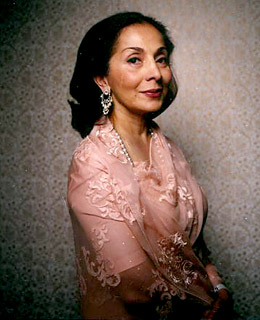
Shamina Khan is one of the most elegant—and least recognized—women in the fashion business. She knows many of the top designers personally and has attended some of the most important shows in New York City, Paris and Milan for nearly 30 years. Her work has appeared in magazines from Vogue to Paper and is sold in the best stores around the world. Even her real name is not known because she shortened it to Khan so the people in the workrooms of Seventh Avenue could pronounce it.
Shamina Talyarkhan, 56, is the owner of Shameeza Embroideries, a small firm that creates lavish beading and embroideries for high-end fashion brands like Valentino, Marc Jacobs and Calvin Klein. Last season, Shameeza shipped more than 2,500 pieces (including ornamented collars, cuffs and entire garments) from its Mumbai (formerly Bombay) factory, accounting for a large percentage of the company's $5.5 million estimated annual earnings.
As designers ante up on luxury this season—Shameeza was commissioned by Ralph Lauren to create a net of Japanese miyuki beads sewn only to one another, which took 700 hours—and consumers continue to crave the unique and handmade, Shameeza's business remains as robust as it was in the freewheeling '80s, despite the dipping economy. Talyarkhan claims she has only a handful of competitors, which include the famed Lesage of Paris. "I think today any lady can wear a beaded dress," she says. "That kind of luxury has gone from the haute couture to the streets. But luxury today is not always refined. I see it. I understand it. But I don't appreciate it."
Thread work is an Indian tradition that dates back to the Mogul emperors, who often had it embellished with gemstones. But Talyarkhan, who was married to a member of the Royal House of Johor, Malaysia, for 26 years, got into the embroidery business by accident. "I wanted to be in fashion," she explains in mixed inflections of Urdu, the Queen's English and French. She began wearing Ungaro, Valentino and Yves Saint Laurent in her early 20s and eventually took a chance by creating a collection of evening clothes based on her own elegant wardrobe.
"In India it is very easy to have something whipped up by a tailor," Talyarkhan says. "But business? I was so naive. I couldn't break into the American market." She changed course after a frustrating meeting with Henri Bendel buyers, who did not think MADE IN INDIA held the proper appeal for their clientele. "I had all these swatches of beading for my little collection," she remembers, "and a friend said, 'You have beautiful embroideries. You should sell them to designers.'" She got her hands on a directory of American labels and called the first name on the list: Anne Klein. It became her first big client.
Talyarkhan divides her time between offices in New York City and Milan and her company's headquarters in Mumbai, a two-story building where 200 workers cover fabric panels with glittering crystals, hand-dyed feathers and a psychedelic rainbow of silk thread.
"Designers will just say something—'Havana' or 'cowboys'—and I have to create," she says. Working from her vast library of swatches and from research provided by design teams, Talyarkhan and her crew translate the designers' ideas into reality.
The two primary techniques—ari, in which a hook like that used in lacemaking is used to attach tiny beads to fabric, and zardozi, involving needles and silk or metallic embroidery thread—have not changed much since the Mogul era. Today test swatches are refined, and then paper patterns are made, indicating the placement of the embroidery.
The motif is then pricked with a pinwheel and lightly dusted with chalk to mark the fabric. Workers, mainly men with particularly skilled hands, attach each bead individually. It can take 250 stitches to embroider a single leaf. Wholesale prices for such work—which are quadrupled by the time the retail customer pays for the finished garment—start at $250 for a simple motif and climb to $30,000 for an encrusted gown.
While countless suppliers of buttons and trim call on designers' studios regularly, Shameeza's work is often so essential to the look of a collection that Talyarkhan communicates directly with designers. "Can you imagine sitting with Armani or Valentino?" she asks. "For a girl from India, it was one thing to live in luxury in Johor. But to sit with the great designers of the world was too much." —Josh Patner / New York